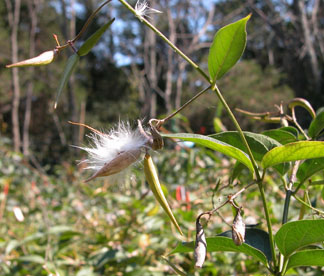Wanted by Cornell and USDA researchers: A natural enemy to curb two invasive, poisonous vines
By Krishna Ramanujan

With no known enemies in North America, two types of invasive vines are growing rampant in forests and fields, threatening reforestation, fragile butterfly populations and bird habitats.
The vines are pale and black swallow-wort, and to find a biological control to stem their growth and their steady conquest of local ecosystems in the northern United States and Canada, Cornell University is teaming up with the U.S. Department of Agriculture's Agricultural Research Service (USDA-ARS), which operates a federal laboratory at Cornell.
Pale and black swallow-wort -- twining vines recently classified as invasive species and members of the milkweed family -- have rapidly spread since the mid-1990s. The plants are lethal hosts for monarch butterfly larvae and alter ground cover and affect habitat for grassland birds. And, if that is not enough, the plants are growing with increasing vigor in some maize and soybean fields and are altering forest regeneration patterns.
Native populations of pale swallow-wort (Vincetoxicum rossicum) in Ukraine and black swallow-wort (V. nigrum) in southwestern Europe are kept in check, though, by native natural enemies. Natural enemies to plants often include moth caterpillars, beetles, flies and diseases.
"They've been here more than 100 years but have exploded in the last 10 to 15 years, and it will still be a minimum of 10 years before we can even release a natural enemy to control their growth," said Antonio DiTommaso, associate professor of weed science at Cornell.
"The collaboration between Cornell and the USDA involves studies of the plants' biology to identify weak links in the life cycle that should be targeted, if possible, for biological control," said Lindsey Milbrath, a USDA-ARS research entomologist at Cornell, adding that introducing any agent will require federal approval. "Our research will help guide the selection of an effective agent."
Milbrath, whose funding from USDA supports the Cornell collaboration on a three-year project, is working with researchers at a USDA facility in Montpellier, France, and other colleagues who are working in Ukraine and southwestern Europe to identify the plants' natural enemies.
The plants contain strong poisons, which likely limit natural enemies. Deer and cattle do not eat them. Researchers also are finding that pale swallow-wort may be replacing milkweeds in open fields in New York state and across the Northeast coast, within the migratory range of monarch butterflies. The monarchs lay their eggs on milkweed, and their larvae eat it as a primary food. Studies have shown that when the monarchs lay their eggs on pale or black swallow-wort, the larvae die within three days.
DiTommaso and his graduate students are investigating whether the plants release root chemicals that alter soil conditions. Preliminary findings suggest that communities of mycorrhizae -- soil fungi that help provide more nutrients to plant roots -- differ in species and abundance in areas surrounding swallow-worts.
"It could be that swallow-worts release chemicals that make an optimal environment for certain mycorrhizal fungi," said DiTommaso.
Through the altered soil, or possibly because of chemicals directly released by the swallow-worts, other plant species have a hard time establishing themselves wherever swallow-worts grow, DiTommaso said.
The pink-flowered pale swallow-wort grows rapidly in both forest understories and in open fields of undisturbed soil throughout central and upstate New York, around the Great Lakes and in Canada. The purple-flowered black swallow-wort prefers open areas and have a foothold in the Hudson Valley, Long Island, southern New York and the New England coast.
Like the common milkweed, swallow-worts release lightweight seeds with featherlike tails that are dispersed by wind and passing deer. Interestingly, between two to eight plants can germinate from each seed.
Media Contact
Get Cornell news delivered right to your inbox.
Subscribe